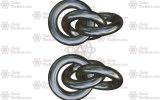What's the Difference?
The answer to the question of "What level of change to weave structure constitutes a new weave as opposed to a variant?" will vary depending on who you ask. However, it is indisputable that even minor changes in weave structure give you a weave that, while it may be similar to the root weave, is "different" from the original. Unfortunately, this often leads to confusion as to what has actually been woven. Each "What's the Difference?" article in the series will focus on a different set of similar and/or commonly confused weaves. There are many occasions where much of the confusion stems from the comparison of different images with the weaves being in multiple orientations and/or ring sizes. Renders made for the articles will be based upon similar AR's and orientation.The renders in this article are made with a wire diameter of 1.63 mm, an actual AR of 3.0, and are woven from left to right. The anchor ring in the following renders is the leftmost cyan ring.
Jens Pind Linkage & False Pind Linkage
- Top - Jens Pind Linkage
- Bottom - False Pind Linkage
Cellular Structure
- Left - Top Down view
- Right - Side view
Weave Cells
- Top Left - JPL weave cell - Top Down view
- Top Right - JPL weave cell - Side view
- Bottom Left - FPL weave cell - Top Down view
- Bottom Right - FPL weave cell - Side view
Cellular Connections
In addition to the configuration and orientation of weave cells, how those weave cells are connected to each other can also have major implications as to what weave you will wind up with.- Top - JPL - Left base cell ring is connected to the right ring of the previous base cell, behind the left ring of that base cell. Right base cell ring is placed in front of the the previous base cells right ring and has no connection of its own to the previous base cell. Cyan reinforcing ring goes through the eye of both it's own weave cell and the eye of the previous base cell above the previous reinforcing ring.
- Bottom - FPL - Same connections as JPL except that the reinforcing ring is connected to the previous base cell eye below the previous reinforcing ring.
Connection Confusion:
- Changing the position of the ring connections (above/below, in front/behind) changes the lean of the grain.
- JPL when rolled has grains that alternate, Left, Right, Left, Right, Left, Right.
- FPL when rolled has grains that alternate Left, Left, Left, Right, Right, Right.
- Grain sequence can change based on orientation when starting and direction of roll.
- The rings in any single grain in either JPL or FPL (when completed) can be designated as the reinforcing grain.
With those weave cells and making those connections, you get the following:
Top - Jens Pind Linkage & Bottom - False Pind Linkage
Conclusion
The sequence of the grain directions is what differentiates Jens Pind Linkage from False Pind Linkage. Changing the lean direction of a single grain is the difference between a weave that is flexible in all directions and one that is not.Appendix
Jens Pind Linkage:
Weave Cell (Both Directions):
Chain (Both Directions):

False Pind Linkage:
Weave Cell (Both Directions):
Chain (Both Directions):

JPL vs FPL comparisons:
Top 2 - JPLBottom 2 - FPL


Reinforcing rings w/ matching orientations:
Top 2 - JPLBottom 2 - FPL
Please note: the red rings (2 in 1 - Persian) in the FPL are the opposite side of the same rings in the JPL .

Cellular Chainmaille Theory - CCT
Cellular Chainmaille Theory (CCT for short) is something that we're working on here at chainmaillers.com. It is currently a work in progress. Cell types and forms used in this article are based upon our current findings. We hope to be able to share more information with you regarding CCT in the future.Author's note:
It is our intent that these articles be living documents where additional information, corrections to any errors, and improvements will be incorporated over time. We encourage any discussion, insights, suggestions, or corrective criticism you may have on the subject presented in this article. This can be done by clicking the "Join the Discussion" button.
If you found this article useful or informative, please leave a rating.
